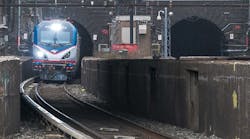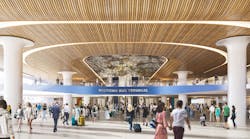The previous Metropolitan Transportation Authority (MTA) Chairman Pat Foye always blamed former President Donald Trump, along with his management team at the United States Department of Transportation (USDOT) and Federal Highway Administration (FHWA), for delays in implementation of congestion pricing. Current MTA Chairman Janno Lieber, by comparison, doesn't offer the same criticism to President Joe Biden, USDOT Sec. Pete Buttigieg or the FHWA for the same lack of progress after 28 months under their watch. The same silence in holding the Biden administration accountable by New York Gov. Kathy Hochul and Sen. Charles Schumer (D-NY) also applies. Neither Hochul or Schumer have offered any criticism of delays under the current Washington administration.
The MTA Traffic Mobility Review Board (TMRB) will never convene until FHWA issues a NEPA finding. This is necessary for future implementation of congestion pricing to proceed. As a result, the TMRB has yet to hold its first meeting to discuss final details of tolling options and who will pay. Nobody knows if this process will be conducted in the light of day or behind closed doors shielded from the public, media and transportation advocates. Buttigieg recently admitted FHWA has no schedule for completion of NEPA. Lieber also claims Gov. Hochul is a big supporter of congestion pricing. He is strangely silent in not holding Hochul accountable for her delays, which contributed to the lack of progress for implementation.
Congestion pricing continues to be politically sensitive. In 2024, members of the New York City (NYC) Council, New York State Assembly and New York State Senate will have to run for reelection. Many will not want to alienate constituents who might be impacted by congestion pricing. It will take one year after FHWA issues the NEPA finding before the TMRB can complete their review and the MTA install equipment necessary for implementation. Only then will tolling start and revenues begin to flow to the MTA.
The MTA TMRB membership includes Carl Weisbrod, a NYC planning and economic development chief who will serve as chairman of the MTA TMRB. He currently is employed with the consultant firm HR&A Advisors.
The other four appointees on the board are the former Real Estate Board of New York President John Banks, a past president of the New York Real Estate Board, Scott Rechler, regional plan association chief and the head of developer RXR Realty, MTA Board Member Elizabeth Velez, who was a past chairperson of the New York Building Congress, and Kathryn Wylde, who heads the partnership for New York City. This organization represents the city’s business community. NYC Mayor Eric Adams appointed NYC Transit Workers Union (TWU) President John Samuelson to be the NYC representative on the board. No commuter or environmental advocacy group leaders were appointed.
Elected officials on all levels of government will lobby for discounts or exemptions for police officers, fire fighters, teachers, low income, NYC outer borough residency, seniors, physically disabled, small commercial delivery businesses, users of electric vehicles, residents living below 60th St. in Manhattan or other special niches. These discounts or exemptions will be adopted to placate their constituents when running for reelection in or 2024. More discounts translates to less revenues.
If approved, New Jersey residents will be paying a portion of revenues generated by congestion price tolling. The MTA estimates it will generate $1 billion annually. These revenues will be used to leverage another $2 billion annually via bonding. This is supposed to raise $15 billion, which will help pay for the MTA $51 billion 2020 - 2024 Five Year Capital Plan. Both New Jersey Transit (NJ Transit) and the Port Authority of New York and New Jersey (PANYNJ) have similar multi year Capital Plans. Many New Jersey residents and elected officials oppose congestion pricing. Some have threatened law suits or introduction of federal legislation to block implementation. The MTA may have to placate them by offering New Jersey a share of revenues generated by new tolls they will be paying.
Some of these dollars could go toward the New Jersey 25 percent share for the $18 billion (two new Hudson River plus rehab of two existing tunnels) or 25 percent share of the $39 billion full scope Gateway project. There is also the $10 billion new PANYNJ 42nd St. midtown Manhattan Bus Terminal along with New Jersey's share of $2 billion toward Gov. Hochul and New Jersey Gov. Phil Murphy's $8 billion Penn Station redevelopment project, There are other NJ Transit and Port Authority Trans Hudson (PATH) capital programs or other transportation improvements that would benefit New Jersey residents.
Thousands of New Yorkers are reverse commuters traveling from Penn Station, Herald Square 34th St. PATH Station and the PANYNJ 42nd St. bus terminal to jobs, schools, sports stadiums, entertainment, Newark Airport and other New Jersey destinations. They benefit by NJ Transit, Port Authority and PATH capital investments.
Nobody can predict if anywhere near $1 billion in annual toll revenues will actually appear. You can't capture five years of toll revenues estimated to be $1 billion per year when you implement the program four and a half years late or after 90 percent of the five year capital program has come and gone. The odds continue to grow that congestion pricing may not be implemented until 2025. This would result in the MTA having to postpone billions in capital projects until the next 2025 - 2029 Five Year Capital Plan.
How will Gov. Hochul assist the MTA in making up for billions in previously anticipated congestion price tolling that may not appear until June 2024 or later, along with previously scheduled fare increase revenues? Who knows if $1 billion in annual toll revenues will actually appear.
There is still a long road ahead before Congestion Pricing becomes a reality.
------------------
Larry Penner is a transportation advocate, historian and writer who previously served as a former director for the Federal Transit Administration Region 2 New York Office of Operations and Program Management. This included the development, review, approval and oversight for billions in capital projects and programs for New Jersey Transit, New York Metropolitan Transportation Authority, NYC Transit bus, subway and Staten Island Railway, Long Island and Metro North railroads, MTA Bus, NYCDOT Staten Island Ferry along with 30 other transit agencies in New York and New Jersey.
------------------







